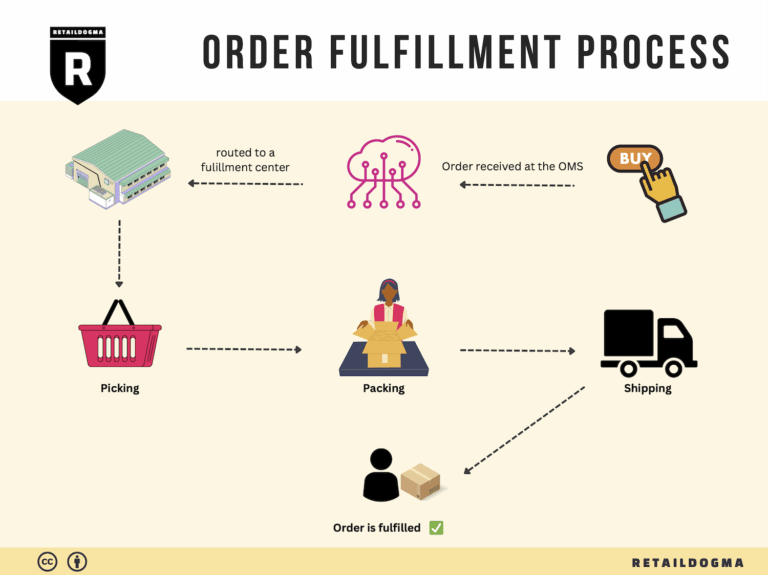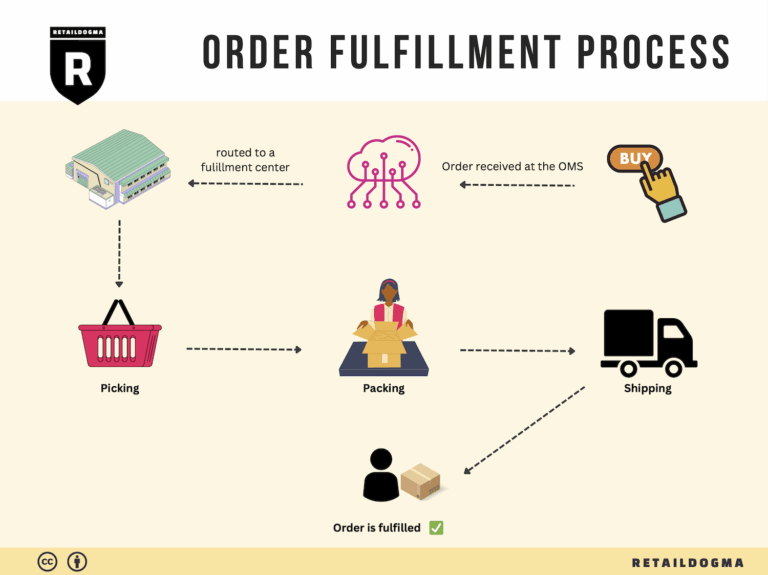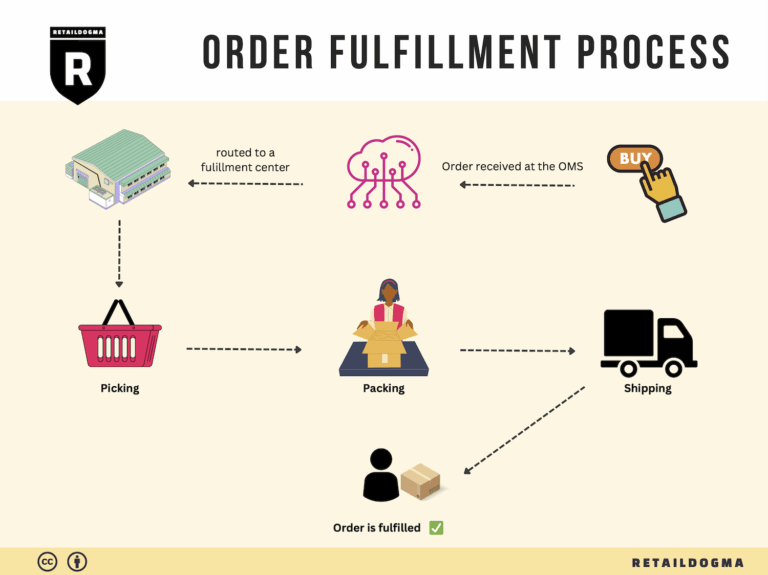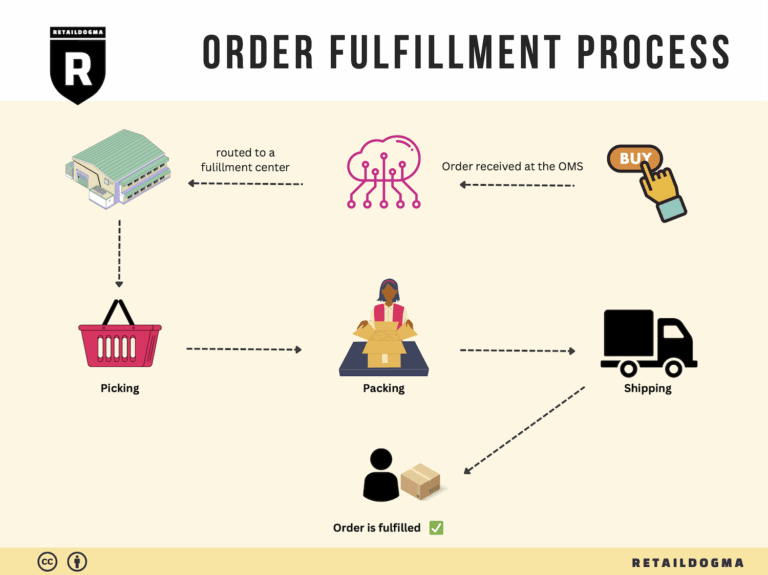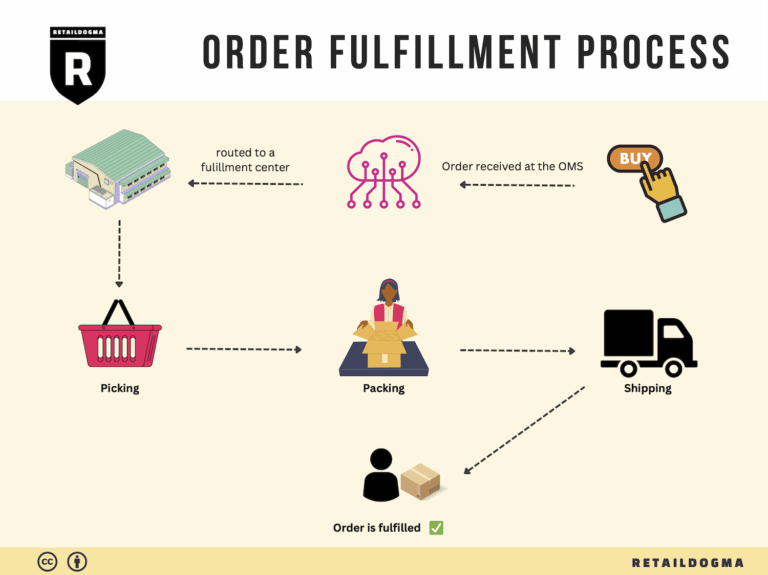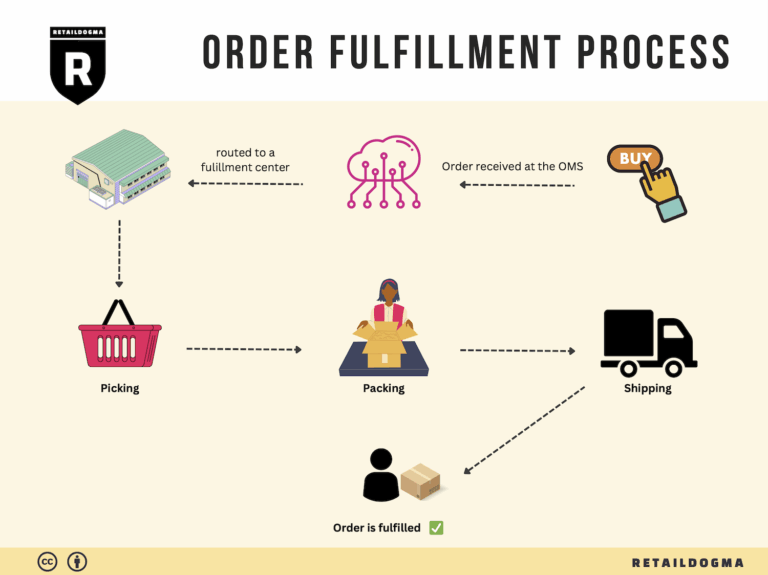How Order Fulfillment Works: A Step-by-Step Guide for Businesses
What is E-commerce Fulfillment? An Introduction for Growing Businesses
As an e-commerce business owner, the excitement of growing your sales can quickly turn into an overwhelming challenge when it comes to packing and shipping orders. The logistics of fulfilling customer orders can be daunting, from managing inventory to ensuring timely delivery. If you find yourself buried under boxes and shipping labels, you’re not alone. Many entrepreneurs experience this common pain point as they scale their operations.
Understanding Fulfillment
At its core, e-commerce fulfillment is the process of getting a product from your warehouse or fulfillment center to the customer’s doorstep. This includes a series of steps: receiving orders, processing payments, picking and packing items, and finally shipping them out. While this process may seem straightforward, the complexity increases with the volume of orders, varying shipping methods, and customer expectations for quick delivery.
What This Guide Covers
In this guide, we will explore the various models of e-commerce fulfillment, including Third-Party Logistics (3PL) and Fulfillment by Amazon (FBA). We will delve into the core services involved in fulfillment—such as inventory management, order processing, and shipping—so you can understand what each option offers.
Additionally, we will provide insights on how to choose the right fulfillment partner for your business. Selecting the right partner is crucial; it can influence not only your operational efficiency but also customer satisfaction and ultimately your bottom line. Pricing is another critical component we will address, helping you to navigate the costs associated with different fulfillment strategies.
Empowering Smart Decisions
The primary goal of this guide is to empower you, the business owner, with the knowledge and tools necessary to make informed decisions about your logistics. By understanding the ins and outs of e-commerce fulfillment, you can streamline your operations, reduce stress, and focus on what you do best—growing your business.
As you progress through this guide, you’ll gain clarity on how to optimize your fulfillment processes, making your logistics not just manageable, but a competitive advantage in the fast-paced world of e-commerce.
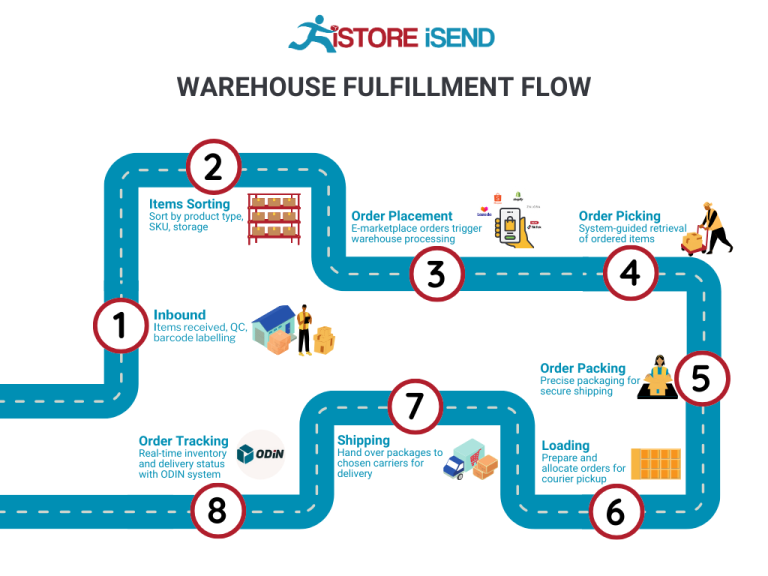
What You’ll Learn In This Guide
- What is E-commerce Fulfillment? An Introduction for Growing Businesses
- The Order Fulfillment Process: From ‘Buy’ Button to Customer’s Door
- Comparing Fulfillment Models: In-House vs. 3PL vs. Dropshipping
- A Deep Dive into Amazon FBA: Pros, Cons, and Who It’s For
- Core Services Offered by Fulfillment Centers
- How to Choose a Fulfillment Partner: A 6-Point Checklist
- Understanding Fulfillment Pricing: A Breakdown of Common Fees
- Frequently Asked Questions (FAQs) about Fulfillment
- Conclusion: Is Outsourcing Fulfillment the Right Move for Your Business?
- Important Disclaimer
The Order Fulfillment Process: From ‘Buy’ Button to Customer’s Door
1. Receiving Inventory
The order fulfillment process begins with receiving inventory from suppliers or manufacturers. This step involves checking incoming shipments for accuracy and quality against purchase orders. Each item is assigned a Stock Keeping Unit (SKU), which is a unique identifier that allows businesses to track inventory levels efficiently.
Importance: Proper inventory receipt ensures that businesses maintain accurate stock levels and avoid discrepancies that can lead to stockouts or overstock situations. A well-organized receiving process minimizes errors and enhances the efficiency of subsequent steps in the fulfillment cycle.
Key Term: SKU – A unique identifier that aids in tracking inventory across the supply chain.
2. Warehouse Storage
Once inventory has been received and checked, the next step is warehouse storage. This involves organizing products within the warehouse in a systematic manner, often using shelving, bins, or pallets to maximize space utilization. Efficient storage methods, such as utilizing a Warehouse Management System (WMS), help in categorizing items based on demand, size, and other factors.
Importance: Effective warehouse storage is crucial for quick access to products during the order picking phase. Properly organized inventory not only speeds up retrieval times but also reduces the likelihood of misplaced items, which can lead to fulfillment delays.
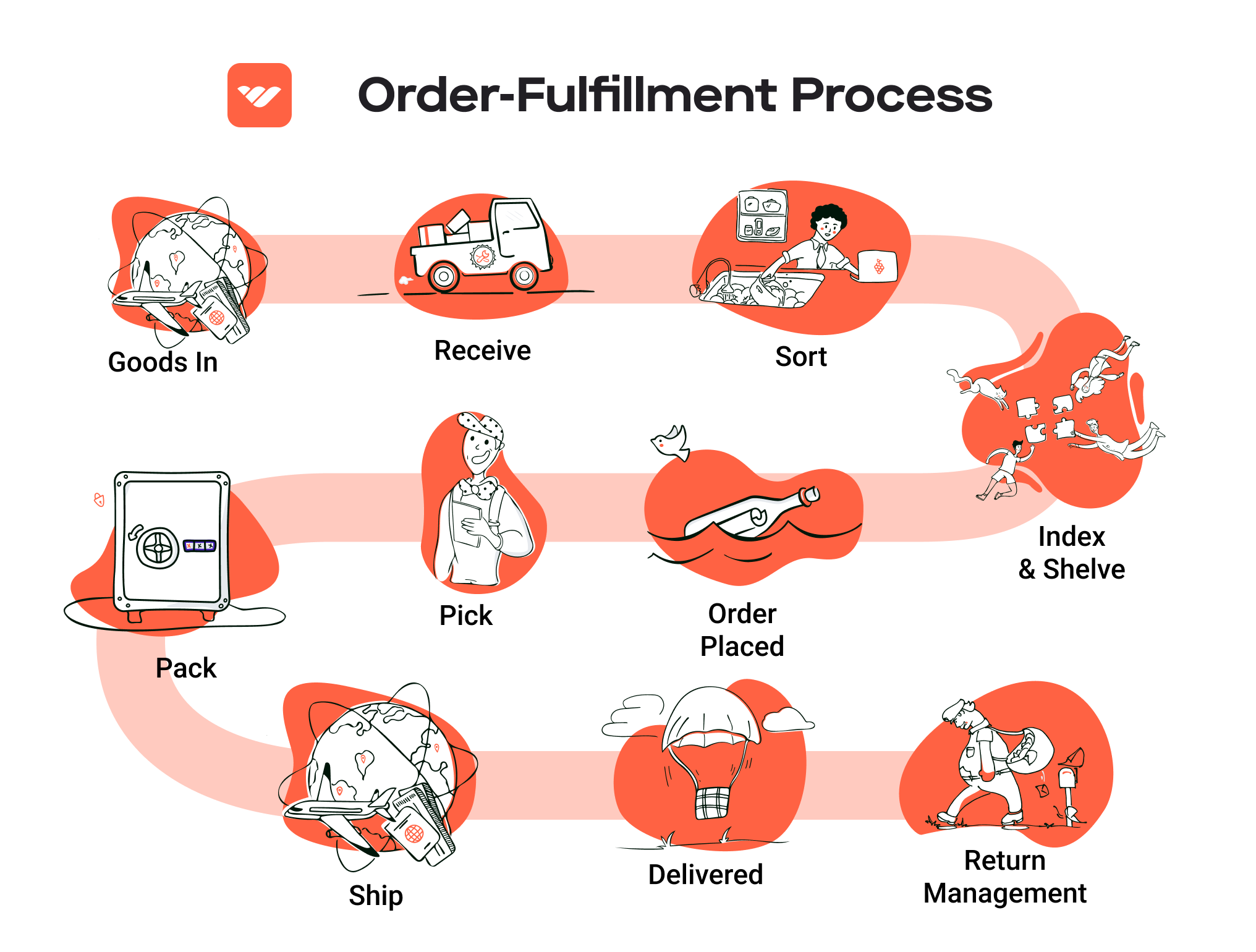
Key Term: Warehouse Management System (WMS) – A software solution that optimizes storage, inventory management, and order fulfillment processes.
3. Order Picking
Order picking is the process of selecting items from the warehouse to fulfill customer orders. This step can be executed in various ways, including single order picking, batch picking, or wave picking, depending on the volume of orders and the structure of the warehouse. Pick lists, which are lists of items to be collected for each order, guide this process.
Importance: Efficient order picking directly impacts delivery speed and accuracy. The faster and more accurately items are picked, the quicker orders can be processed and shipped. A streamlined picking process can significantly enhance customer satisfaction by ensuring timely deliveries.
Key Term: Pick List – A document or digital list that outlines the items and quantities to be picked for fulfilling specific orders.
4. Order Packing
After items have been picked, they move to the order packing stage. Here, products are carefully packed into boxes or envelopes, with attention to detail to ensure they are secure and protected during transit. Packaging should also include necessary documentation, such as packing slips and invoices, and may involve branding considerations to enhance the customer experience.
Importance: Proper packing not only protects products from damage but also reflects the professionalism of the business. Well-packed orders minimize returns due to damage and can lead to higher customer satisfaction and repeat purchases.
Key Term: Packing Slip – A document included in the shipment that lists the items being sent, which serves as a receipt for customers.
5. Shipping & Delivery
The final step in the order fulfillment process is shipping and delivery. This involves selecting the appropriate shipping carrier based on factors such as cost, speed, and reliability. Once the package is shipped, tracking information is generated, allowing customers to monitor their orders in real-time.
Importance: Efficient shipping and delivery are critical to customer satisfaction and retention. The choice of carrier and shipping method can significantly impact delivery times, costs, and overall customer experience. Businesses that offer reliable and fast shipping options are more likely to attract and retain customers.
Key Term: Tracking Information – A unique code provided by the shipping carrier that allows customers to track the status and location of their order during transit.
By understanding and optimizing each of these five steps, e-commerce businesses can create a robust order fulfillment process that not only meets but exceeds customer expectations, ultimately driving growth and scalability in their operations.
Comparing Fulfillment Models: In-House vs. 3PL vs. Dropshipping
Fulfillment Model Comparison Table
| Model | Who Handles Inventory | Best For (Business Stage) | Key Advantage | Key Disadvantage |
|---|---|---|---|---|
| In-House Fulfillment | Business Owner/Staff | Startups to Mid-sized Firms | Complete control over inventory and process | High overhead costs and resource demands |
| Third-Party Logistics (3PL) | 3PL Provider | Growth to Established Firms | Scalability and cost-effectiveness | Less control over the fulfillment process |
| Dropshipping | Supplier/Manufacturer | Startups and Niche Markets | Low startup costs and minimal risk | Lower profit margins and dependency on suppliers |
In-House Fulfillment
In-house fulfillment refers to the process where a business manages its own inventory and order fulfillment operations. This model is often favored by startups and mid-sized firms that want to maintain complete control over their inventory and the customer experience. By handling everything internally, businesses can customize their fulfillment processes to align with their brand values and operational strategies. This level of control can facilitate better quality assurance, personalized customer service, and faster response times. However, managing fulfillment in-house comes with significant challenges. The overhead costs can be high due to the need for warehousing space, staff, and equipment. Additionally, businesses may face scalability issues as they grow, requiring more resources and potentially leading to operational bottlenecks.
Third-Party Logistics (3PL)
Third-party logistics (3PL) providers offer a comprehensive solution for businesses looking to outsource their fulfillment processes. In this model, the 3PL partner handles inventory storage, order processing, packing, and shipping, allowing businesses to focus on their core competencies. This option is best suited for companies in growth stages or those that have reached a level of operational complexity where in-house fulfillment becomes burdensome. The key advantage of using a 3PL is the ability to scale quickly without significant capital investment in infrastructure. Businesses can benefit from the expertise of logistics professionals, access to advanced technology, and established shipping networks. However, this model also presents challenges, as businesses relinquish some control over their fulfillment processes. Poor communication or service from the 3PL can lead to delays, errors, and a negative customer experience.
Dropshipping
Dropshipping is an increasingly popular fulfillment model, particularly for startups and niche markets. In this arrangement, businesses sell products without holding any inventory. Instead, when a customer places an order, the business purchases the item from a third-party supplier who then ships it directly to the customer. This model significantly lowers startup costs and eliminates the risks associated with unsold inventory, making it an attractive option for entrepreneurs testing new product ideas or entering competitive markets. However, dropshipping also has its drawbacks. Profit margins can be slimmer due to the reliance on suppliers, and businesses may face challenges with quality control, shipping times, and customer service. Additionally, the dependence on suppliers can lead to issues if they run out of stock or fail to deliver on time, which can negatively impact the business’s reputation and customer satisfaction.
Conclusion
Choosing the right fulfillment model is crucial for e-commerce success, and the best choice depends on your business’s specific needs, growth stage, and operational capabilities. In-house fulfillment offers control but can be resource-intensive, while 3PL provides scalability at the expense of some control. Dropshipping lowers risk and investment but can lead to challenges in quality and service. As e-commerce continues to evolve, understanding these models will empower business owners and operations managers to make informed decisions that align with their strategic goals.
A Deep Dive into Amazon FBA: Pros, Cons, and Who It’s For
Understanding Fulfillment by Amazon (FBA)
Fulfillment by Amazon (FBA) is a service offered by Amazon that allows sellers to store their products in Amazon’s fulfillment centers. Amazon then takes care of storage, packaging, shipping, and customer service on behalf of the sellers. This means that when a customer orders a product, Amazon handles the entire fulfillment process, including returns and customer inquiries. FBA has become a popular choice for e-commerce businesses looking to leverage Amazon’s vast logistics network and customer base.
How FBA Works
-
Setup: Sellers begin by creating an Amazon seller account and enrolling in the FBA program. They then prepare their products according to Amazon’s guidelines and ship them to Amazon’s fulfillment centers.
-
Storage: Once received, Amazon stores the inventory in its warehouses. The seller’s products are listed on Amazon’s marketplace, and customers can purchase them as they would any other item on Amazon.
-
Order Fulfillment: When a customer places an order, Amazon picks, packs, and ships the product directly to the customer. This includes managing the logistics of shipping, which can be a significant advantage for sellers.
-
Customer Service: Amazon also handles all customer service inquiries, including returns and refunds. This allows sellers to focus on other aspects of their business while ensuring a high level of customer satisfaction.
-
Multi-Channel Fulfillment: Beyond just Amazon, sellers can use FBA to fulfill orders from other sales channels, such as their own websites or other online marketplaces, giving them flexibility and broadening their reach.
Pros of Using FBA
-
Prime Eligibility: Products fulfilled by Amazon are automatically eligible for Amazon Prime, providing sellers access to millions of Prime members. This can significantly increase sales, as many customers prefer Prime-eligible products for the free and fast shipping.
-
Customer Trust: Amazon has built a strong reputation for reliability and customer service. By using FBA, sellers benefit from this trust, as customers are more likely to purchase products that are fulfilled by Amazon due to their established return policies and customer support.
-
Scalability: FBA allows sellers to scale their business without the need to invest heavily in their own warehousing and logistics. As sales grow, sellers can easily send more inventory to Amazon without worrying about the logistics of storage and shipping.
-
Multi-Channel Fulfillment: As mentioned earlier, FBA can handle orders from multiple channels. This means that sellers can streamline their operations by using Amazon’s infrastructure for all their orders, not just those made through Amazon.
-
Time Savings: Outsourcing fulfillment to Amazon allows sellers to focus on their core business activities, such as marketing and product development, rather than getting bogged down in logistics.
Cons of Using FBA
-
High Fees: While FBA provides numerous benefits, it comes at a cost. Sellers must pay for storage, fulfillment, and additional services, which can cut into profit margins. These fees can vary based on factors such as the size and weight of products, and they can add up quickly.
-
Strict Inventory Rules: Amazon has strict guidelines regarding inventory management, including how products must be packaged and labeled. Sellers must comply with these rules to avoid penalties or the risk of their products being removed from the marketplace.
-
Commingling Risks: FBA uses a process known as commingling, where inventory from different sellers is stored together. This can lead to issues if a seller’s product is mixed with lower-quality items from other sellers, potentially damaging their reputation and affecting customer satisfaction.
-
Limited Control: When using FBA, sellers relinquish some control over the fulfillment process. Issues such as order inaccuracies or delays in shipping may arise, and sellers must rely on Amazon to resolve these problems.
-
Inventory Storage Limits: Amazon imposes limits on how much inventory sellers can store in their fulfillment centers. This can be particularly challenging for sellers with seasonal products or those who experience rapid sales growth.
Who is FBA Best For?
Fulfillment by Amazon is particularly well-suited for:
-
Small to Medium-Sized Sellers: Businesses that may not have the resources to manage their own logistics can benefit significantly from outsourcing fulfillment to Amazon.
-
Brands Seeking Rapid Growth: Sellers looking to scale quickly and tap into Amazon’s vast customer base will find FBA advantageous.
-
E-commerce Entrepreneurs: Those focused on marketing and sales rather than logistics will appreciate the time and effort saved by using FBA.
-
Businesses with Seasonal Products: FBA allows sellers to manage inventory without the burden of warehousing, making it easier to adjust stock levels based on seasonal demand.
-
Multi-Channel Sellers: Brands that sell on multiple platforms can benefit from Amazon’s logistics capabilities to streamline their operations.
In conclusion, Fulfillment by Amazon can be a powerful tool for e-commerce businesses looking to expand their reach and improve their fulfillment process. While there are significant advantages, potential sellers must carefully weigh the costs and operational implications to determine if FBA is the right fit for their business strategy.
Core Services Offered by Fulfillment Centers
Inventory Management & Warehousing
Effective inventory management is the backbone of a successful e-commerce operation. Fulfillment centers provide sophisticated warehousing solutions that allow businesses to store their products efficiently. This service encompasses everything from receiving inventory to tracking stock levels and managing product locations within the warehouse.
Benefits:
-
Optimized Storage: Fulfillment centers utilize advanced inventory management systems that ensure optimal use of space. This means businesses can store more products without the need for larger warehouse facilities.
-
Real-Time Tracking: By leveraging technology, fulfillment centers offer real-time inventory tracking. This allows e-commerce businesses to have a clear understanding of stock levels, reducing the risk of overstocking or stockouts.
-
Scalability: As your business grows, so do your inventory needs. Fulfillment centers provide scalable solutions, allowing businesses to easily increase or decrease storage space based on seasonal demands or business growth.
-
Reduced Overhead Costs: By outsourcing warehousing to a fulfillment center, businesses can save on the costs associated with maintaining their own warehouse, such as rent, utilities, and staffing.
Pick and Pack Services
Pick and pack services are integral to the fulfillment process. This service involves selecting the ordered items from the inventory (picking) and packaging them appropriately for shipment (packing). Fulfillment centers streamline this process, ensuring that orders are processed quickly and accurately.
Benefits:
-
Efficiency: Fulfillment centers are designed for high-volume order processing. They employ trained staff and efficient systems to ensure that orders are picked and packed with speed and accuracy, which is essential for maintaining customer satisfaction.
-
Error Reduction: With automated systems and quality control checks in place, fulfillment centers significantly reduce the chances of errors in order fulfillment, minimizing the risk of returns and customer dissatisfaction.
-
Customization: Many fulfillment centers offer customizable packing options, allowing businesses to enhance their brand image through personalized packaging. This can include branded boxes, inserts, or special wrapping, creating a memorable unboxing experience for customers.
-
Faster Delivery Times: By optimizing the pick and pack process, fulfillment centers can ship orders faster, leading to improved customer satisfaction and repeat business. Quick order fulfillment is crucial in today’s competitive e-commerce landscape.
Kitting and Assembly
Kitting and assembly services involve grouping various products together to create a single package or preparing products for sale. This service is especially beneficial for businesses that sell bundled products or require assembly prior to shipping.
Benefits:
-
Enhanced Product Offerings: Kitting allows businesses to create unique product bundles or kits that can attract more customers. This not only increases the average order value but also provides a competitive edge in the marketplace.
-
Time Savings: By outsourcing kitting and assembly to a fulfillment center, businesses can save time and focus on core activities such as marketing and customer service. This allows for greater operational efficiency and resource allocation.
-
Quality Control: Fulfillment centers typically have dedicated teams for kitting and assembly, ensuring that each kit is assembled correctly and meets quality standards. This reduces the likelihood of customer complaints related to product quality.
-
Inventory Management: Kitting can simplify inventory management by reducing the number of SKUs a business has to track. Instead of managing multiple individual items, businesses can manage fewer bundled products, simplifying the overall logistics.
Returns Management (Reverse Logistics)
Returns management, or reverse logistics, is a critical service provided by fulfillment centers that involves handling product returns efficiently. This process includes receiving returned items, inspecting them, restocking them, or managing their disposal.
Benefits:
-
Streamlined Process: A well-managed returns process can significantly enhance customer satisfaction. Fulfillment centers streamline the returns process, making it easy for customers to return products and for businesses to manage these returns.
-
Cost Efficiency: By outsourcing returns management, businesses can reduce costs associated with handling returns in-house. Fulfillment centers can process returns more efficiently, often at a lower cost due to their established systems and workflows.
-
Data Insights: Fulfillment centers can provide valuable data on return reasons and trends, helping businesses identify potential issues with products. This information can guide product improvements and inform inventory decisions.
-
Improved Customer Loyalty: A hassle-free returns process can foster customer loyalty. When customers know they can easily return items, they are more likely to make purchases, leading to higher overall sales and positive brand perception.
In conclusion, partnering with a fulfillment center can provide e-commerce businesses with essential services that enhance operational efficiency, reduce costs, and improve customer satisfaction. By leveraging these core services—inventory management, pick and pack, kitting and assembly, and returns management—businesses can scale effectively and thrive in the competitive e-commerce landscape.
How to Choose a Fulfillment Partner: A 6-Point Checklist
Location & Warehouse Network
Importance:
The geographical location of a fulfillment partner’s warehouses significantly affects shipping times and costs. A partner with multiple warehouses strategically located near your customer base can enhance delivery speed, reduce shipping expenses, and improve customer satisfaction.
Questions to Ask:
– Where are your warehouses located, and how do they align with my target market?
– Do you have a network of fulfillment centers, and can they support international shipping if I expand my business?
– What are your average delivery times for major regions I plan to serve?
Technology & Integrations
Importance:
In today’s fast-paced e-commerce environment, having a robust technological framework is essential for efficient operations. A fulfillment partner should offer a user-friendly platform that integrates seamlessly with your existing e-commerce systems, such as your online store, inventory management software, and accounting tools.
Questions to Ask:
– What technology platform do you use for order management and tracking?
– Can your systems integrate with my existing e-commerce platforms (e.g., Shopify, WooCommerce, Amazon)?
– How do you handle inventory management, and what real-time tracking capabilities do you provide?
Specializations (e.g., Cold Storage, Oversized Items)
Importance:
Different businesses have unique fulfillment needs. If your products require specific handling, such as temperature-controlled storage for perishables or special packaging for oversized items, it’s crucial to choose a partner with the right capabilities.
Questions to Ask:
– Do you specialize in any specific types of products or fulfillment processes?
– What facilities or equipment do you have in place for handling specialized items?
– Can you accommodate fluctuating inventory levels for seasonal products or promotional campaigns?
Scalability & Capacity
Importance:
As your business grows, your fulfillment needs will likely change. It’s essential to partner with a fulfillment provider that can scale operations in line with your growth—whether that means increasing storage capacity, processing more orders, or expanding to new markets.
Questions to Ask:
– How do you handle increased order volumes during peak seasons or promotional events?
– What is your capacity for scaling operations as my business grows?
– Are there any limitations on the types of products or volumes you can handle?
Pricing and Contracts
Importance:
Understanding pricing structures is key to managing your fulfillment costs effectively. Different providers may have various fee structures, including storage fees, pick and pack fees, shipping costs, and any additional charges for special services.
Questions to Ask:
– Can you provide a detailed breakdown of your pricing model, including any hidden fees?
– What are the terms of your contracts? Are there any long-term commitments or cancellation policies?
– How do you handle pricing adjustments in response to changes in shipping costs or other factors?
Customer Support & Reviews
Importance:
Reliable customer support is vital in addressing issues that may arise during the fulfillment process. A partner with strong customer service can help ensure smooth operations, timely resolutions, and a better overall experience for your customers.
Questions to Ask:
– What customer support channels do you offer (e.g., phone, email, chat), and what are your response times?
– Can you provide references or case studies from current or past clients in my industry?
– How do you handle complaints or issues related to order fulfillment, and what is your process for escalation?
Conclusion
Choosing the right fulfillment partner is a critical decision that can impact your e-commerce business’s efficiency, customer satisfaction, and ultimately, profitability. By using this checklist and asking the right questions, you can make an informed choice that aligns with your business goals and growth plans. As you evaluate potential partners, remember to consider not only their current capabilities but also their willingness to adapt and grow with your evolving needs.
Understanding Fulfillment Pricing: A Breakdown of Common Fees
Initial Setup Fees
When partnering with a fulfillment service, businesses often encounter initial setup fees. These fees cover the costs associated with onboarding your account, configuring your inventory in the system, and integrating your e-commerce platform with the fulfillment center’s technology. Setup fees can vary significantly based on the complexity of your needs and the provider’s capabilities, but they typically range from $100 to $1,000.
To get an accurate estimate, clarify what services are included in the setup fee. Are they just for account creation, or do they also cover training and support for your team? Additionally, inquire whether any ongoing support or maintenance fees will apply post-setup.
Receiving Fees
Receiving fees are charged when the fulfillment center accepts your inventory. This fee typically includes unpacking, inspecting, and entering items into the warehouse management system (WMS). The cost can be calculated per unit received, with rates usually falling between $0.25 to $1.00 per item.
Factors that may influence receiving fees include the volume of items being received, their size, and any special handling requirements. To avoid surprises, ask the fulfillment provider about their policies regarding damaged or missing items during the receiving process, as this can impact your overall costs.
Storage Fees (per pallet/bin)
Storage fees are charged for the space your inventory occupies within the fulfillment center. These fees can be calculated per pallet or per bin, depending on how the provider organizes their warehouse. On average, storage fees range from $10 to $50 per pallet per month, while bin storage might be charged at $2 to $5 per bin per month.
It’s crucial to understand how the provider defines a “pallet” or “bin” and whether they have minimum storage requirements. Additionally, some providers may implement tiered pricing structures based on the volume of inventory stored, which could benefit businesses with larger inventories.
Pick & Pack Fees (per item/order)
Pick and pack fees cover the labor and materials involved in selecting items from inventory and preparing them for shipment. This fee is typically charged per item or per order and can range from $0.50 to $2.00 per item. For example, if an order contains three items, you may be charged three separate pick fees.
Some fulfillment centers offer a flat rate for orders up to a certain number of items, while others may have a sliding scale based on order complexity. It’s essential to clarify how the provider calculates these fees and whether there are additional costs for special packing requirements, such as gift wrapping or custom packaging.
Shipping Fees
Shipping fees are one of the most variable costs in the fulfillment process and can significantly impact your overall fulfillment expenses. These fees are determined by factors such as package weight, dimensions, destination, and shipping speed. Providers often negotiate rates with carriers, so you may find that shipping fees vary widely between different fulfillment partners.
Most fulfillment centers will offer a shipping rate calculator or provide you with estimates based on your shipping preferences. To keep shipping costs manageable, consider discussing options for bulk shipping discounts or exploring whether the provider can offer flat-rate shipping for certain regions or products.
Conclusion: Tips for Getting an Accurate Quote
To ensure you receive an accurate quote from a fulfillment provider, follow these tips:
-
Be Transparent: Clearly communicate your business’s specific needs, including order volume, types of products, and seasonal fluctuations.
-
Request Detailed Pricing Structures: Ask for a breakdown of all potential fees, including those that may not be immediately apparent, such as returns processing or long-term storage costs.
-
Compare Providers: Don’t settle for the first quote you receive. Compare pricing and services from multiple providers to find the best fit for your business.
-
Understand Contract Terms: Pay attention to the terms of service and any potential hidden fees in the contract.
-
Inquire About Discounts: Ask about bulk discounts or promotional rates that could lower your overall fulfillment costs.
By thoroughly understanding these common fees and preparing to ask the right questions, you can make informed decisions that will help scale your e-commerce operations effectively.
Frequently Asked Questions (FAQs) about Fulfillment
1. What is fulfillment in e-commerce?
Fulfillment in e-commerce refers to the entire process of receiving, processing, and delivering orders to customers. It encompasses various steps, including order processing, inventory management, picking and packing items, shipping, and handling returns. Efficient fulfillment is crucial for customer satisfaction and can significantly impact your business’s reputation and growth.
2. What’s the difference between fulfillment and fulfilment?
There is no difference in meaning; the distinction lies solely in regional spelling. “Fulfillment” is the American English spelling, while “fulfilment” is used in British and Australian English. When engaging in international trade, it’s essential to use the appropriate spelling based on your target market.
3. What is a fulfillment center?
A fulfillment center is a specialized warehouse where e-commerce businesses store their products. These centers handle the logistics of order processing, inventory management, and shipping. Unlike traditional warehouses, fulfillment centers are designed to facilitate quick and efficient order fulfillment, often incorporating technology to streamline operations.
4. How is a warehouse different from a fulfillment center?
While both warehouses and fulfillment centers store products, their purposes differ. Warehouses primarily focus on inventory storage and management, often for bulk goods. In contrast, fulfillment centers are tailored for e-commerce operations, emphasizing fast order processing, picking, packing, and shipping directly to customers.
5. What is a 3PL, and how can it benefit my business?
A Third-Party Logistics (3PL) provider is a company that manages logistics and fulfillment services for other businesses. Utilizing a 3PL can reduce operational costs, enhance efficiency, and allow you to focus on core business activities. They offer expertise in areas like shipping, warehousing, and inventory management, which is especially valuable for scaling e-commerce operations.
6. How much do fulfillment services cost?
The cost of fulfillment services varies widely based on factors such as order volume, storage space, and additional services like packaging or kitting. Typically, businesses can expect to pay a monthly fee for storage plus a per-order fee that covers picking, packing, and shipping. It’s essential to obtain quotes from multiple providers to find the best fit for your budget and needs.
7. What factors should I consider when choosing a fulfillment partner?
When selecting a fulfillment partner, consider their location, technology integration, shipping options, scalability, and customer service. Evaluate their ability to handle your specific product types, fulfillment speed, and reliability. Additionally, look for partners that offer transparent pricing and robust reporting tools to track your fulfillment performance.
8. How can I improve my fulfillment process?
To enhance your fulfillment process, consider implementing automated systems for inventory management and order processing. Streamlining communication between your sales and fulfillment teams can also reduce errors. Regularly analyze fulfillment metrics such as order accuracy and shipping times to identify areas for improvement.
9. What is the role of technology in fulfillment?
Technology plays a critical role in modern fulfillment processes. Advanced software solutions facilitate inventory management, order tracking, and analytics, helping businesses streamline operations and improve accuracy. Automation technologies, such as robotic picking systems, can further enhance efficiency and reduce labor costs.
10. How does international fulfillment differ from domestic fulfillment?
International fulfillment involves additional complexities, such as customs regulations, international shipping costs, and longer delivery times. Businesses must navigate different tariffs and compliance requirements for each country they ship to. Partnering with a 3PL that specializes in international logistics can simplify these challenges and ensure a smoother fulfillment process.
Conclusion: Is Outsourcing Fulfillment the Right Move for Your Business?
Evaluating the Benefits of Outsourcing Fulfillment
Outsourcing fulfillment can be a transformative decision for e-commerce businesses looking to scale efficiently. The primary advantages of partnering with a fulfillment service include time savings, enhanced scalability, and access to specialized expertise.
By outsourcing fulfillment, you can redirect valuable time and resources from managing logistics to focusing on core business functions such as product development, marketing, and customer engagement. Fulfillment partners streamline order processing, inventory management, and shipping, allowing you to respond more quickly to market demands and customer expectations.
Scalability is another significant benefit. As your business grows, managing increased order volumes can become overwhelming. Fulfillment services are designed to scale with your business, providing the infrastructure needed to handle fluctuations in demand, whether it’s seasonal spikes or new product launches. This flexibility ensures that you can maintain service quality without the burden of investing in additional warehousing or staffing.
Moreover, fulfillment partners bring industry expertise that can enhance operational efficiency. They understand the nuances of logistics, including international shipping regulations, customs, and best practices for inventory management. This knowledge can lead to reduced shipping costs and improved delivery times, further enhancing customer satisfaction.
However, the success of outsourcing fulfillment hinges on selecting the right partner. It’s crucial to assess potential providers based on their capabilities, technology integration, and customer service track record. A misalignment could hinder your growth rather than support it.
Strategic Call-to-Action
To determine if a fulfillment partner is the right next step for your business, conduct a thorough audit of your current shipping and logistics processes. Evaluate your operational challenges, customer feedback, and growth goals. This assessment will help you identify whether the benefits of outsourcing fulfillment align with your business objectives and set the stage for a more efficient and scalable future.
Important Disclaimer
⚠️ Important Disclaimer
The information in this guide is for educational purposes. Fulfillment services, pricing, and platform features change frequently. Always conduct your own due diligence and consult with providers directly before making business decisions.

